Papers by Sachidanand Jee Bharati

Indian Journal of Palliative Care, 2021
Objectives: Rheumatoid arthritis (RA) is a chronic disorder causing inflammation in the joints an... more Objectives: Rheumatoid arthritis (RA) is a chronic disorder causing inflammation in the joints and achieving remission is often the primary goal of physicians. We evaluated the suffering from RA and assessed the need for palliative care services in these patients. Materials and Methods: This cross-sectional observational study was done in 100 adult RA cases who attended the outpatient department. The Disease Activity Score 28 (DAS28), Health Assessment Questionnaire Disability Index, depression, anxiety and stress score, Short Form 36 Health Survey and numeric rating scale were assessed. The relationship between DAS28 with the other parameters and scores was assessed using Spearman’s rho correlation coefficient. Results: About 90% of patients in our study were female and majority (50%) had a moderate disease activity. The DAS28 showed a positive correlation with the degree of depression (r = 0.671, P = 0.000), anxiety (r = 0.609, P = 0.000) and stress levels (r = 0.474, P = 0.000). ...

Due to recent advances in medicine, the mortality from chronic diseases is decreasing. More and m... more Due to recent advances in medicine, the mortality from chronic diseases is decreasing. More and more patients are presenting with complex chronic progressive diseases where only symptomatic cure is possible. Such interventions are considered palliative and are based on the patient’s symptoms and disease status. WHO defines “palliative care as an approach that improves the quality of life of patients and their families facing the problem associated with a life-threatening illness, through the prevention and relief of suffering employing early identification, impeccable assessment, and treatment of pain and other problems, physical, psychosocial and spiritual.” In an oncology setup, up to 10–15% of patients may present for palliative surgery. Other nonmalignant conditions like Human immunodeficiency virus infection and acquired immune deficiency syndrome (HIV/AIDS), organ transplant recipients, chronic systemic diseases (cardiac, respiratory, renal, and hepatic systems) also present f...
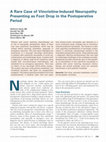
AANA journal, 2020
Patients with cancer receiving chemotherapy are at risk of neuropathy development. Many of them m... more Patients with cancer receiving chemotherapy are at risk of neuropathy development. Many of them may have subclinical neuropathies, which may be missed before planning anesthesia, especially in emergency scenarios. This case report highlights the importance of a thorough neurologic examination in patients with subclinical neuropathy to avoid any complications and medicolegal issues. A patient with a diagnosis of diffuse large B-cell lymphoma being treated with vincristine-based chemotherapy was scheduled for an emergency laparotomy. There was no history of any neurologic deficit before surgery. The surgery was done using general anesthesia, and intrathecal morphine was given for postoperative analgesia. This patient experienced bilateral foot drop postoperatively. A bilateral lower limb and upper limb sensory-motor neuropathy was detected on a nerve conduction study, probably due to vincristine-induced peripheral neuropathy. The literature is deficient regarding manifestations of neu...
Saudi Journal of Anaesthesia, 2020
1. Krishnakumar M, Sharma R, Pawar HS, Hasnain S. Anaesthetic management of left main bronchial g... more 1. Krishnakumar M, Sharma R, Pawar HS, Hasnain S. Anaesthetic management of left main bronchial glomus tumour. Indian J Anesthesia 2016;60:276‐9. 2. Cornelius B, Sakai T. Inadvertent Endobronchial Intubation in a Patient With a Short Neck Length. Anesth Prog 2015;62:66‐70. 3. Camilo J, Salguero S. Perioperative management of massive hemoptysis during flexible bronchoscopy. Colombian J Anesthesiol 2017;45:256‐61. 4. Gardner JC, Royster RL. Airway collapse with an anterior mediastinal mass despite spontaneous ventilation in an adult. Anesth Analg 2011;113:239‐42. 5. Lin F, Pan L, Qian W, Ge W, Dai H, Lian Y, et al. Comparison of three ventilator modes during OLV in elderly patients. Int J Clin Exp Med 2015;8:9955‐96.
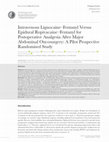
Turkish Journal of Anaesthesiology and Reanimation, 2020
Objective: Epidural injection of local anaesthetics and intravenous opioid injection are two comm... more Objective: Epidural injection of local anaesthetics and intravenous opioid injection are two common analgesic strategies following major abdominal oncosurgery. However, epidural local anaesthetics may cause haemodynamic instability while opioid injection is associated with sedation and postoperative ileus. Intravenous lignocaine is also used for postoperative analgesia, and combined use of opioids plus lignocaine can reduce the doses and adverse effects of the individual drugs. This study therefore compared the analgesic efficacy of intravenous lignocaine-fentanyl (IV) to epidural ropivacaine-fentanyl (EPI) after major abdominal oncosurgery. Methods: Sixty patients were randomised to IV and EPI groups. Patients in the IV group received preoperative intravenous bolus injections of lignocaine 1.5 mg kg −1 and fentanyl 0.5 µg kg −1 , intraoperative infusions of lignocaine 1 mg kg −1 h −1 and fentanyl 0.5 µg kg −1 h −1 , and postoperative infusions of lignocaine 0.5 mg kg −1 h −1 and fentanyl 0.25 µg kg −1 h −1. In the EPI group, patients received a 6-ml epidural bolus injection of ropivacaine 0.2% plus fentanyl 2 µg mL −1 , intraoperative infusion of 5 mL•h −1 fentanyl and postoperative ropivacaine 0.1% plus fentanyl 1 µg mL −1 infusion at 5 mL h −1. All patients also received postoperative patient-controlled IV fentanyl as rescue analgesia. Patient-controlled fentanyl consumption was documented as the primary outcome for postoperative analgesic efficacy. Results were compared by Mann-Whitney U-test and Student's t-test using Statistical Package for Social Science (SPSS) software. Results: Median (min-max) rescue fentanyl requirement in the first 24 h postsurgery was comparable between IV and EPI groups [780 (340-2520) µg vs. 820 (140-2260) µg; p=0.6], as was postoperative pain score (p>0.05). The incidence of intraoperative hypotension requiring bolus mephenteramine injection was significantly higher in the EPI group than the IV group (36% vs. 17%; p<0.001). Conclusion: Intravenous lignocaine-fentanyl and epidural ropivacaine-fentanyl have comparable postoperative analgesic efficacies after major open abdominal oncosurgery.
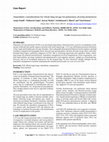
Ghana Medical Journal, 2019
Pulmonary alveolar proteinosis (PAP) is an uncommon lung disease characterized by excessive accum... more Pulmonary alveolar proteinosis (PAP) is an uncommon lung disease characterized by excessive accumulation of pulmonary surfactant that usually requires treatment with whole-lung lavage. A 47-year-old female presented with history of dry cough and breathlessness for past 6months. Chest radiograph demonstrated bilateral alveolar shadows and high resolution computerized tomography thorax showed crazy paving pattern. Broncho-alveolar lavage (BAL) and transbronchial lung biopsy confirmed a diagnosis of PAP. Due to worsening hypoxemia and respiratory failure, wholelung lavage was planned and performed. Anaesthetic management involved integrated use of pre-oxygenation, complete lung isolation, one-lung ventilation with optimal positive end-expiratory pressure, vigilant use of positional manoeuvres, and use of recruitment manoeuvres for the lavaged lung. We have discussed valuable strategies for the anaesthetic management of patients undergoing this multifaceted procedure in a case of severe PAP.
Indian Journal of Medical and Paediatric Oncology, 2018
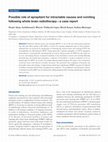
Annals of Palliative Medicine, 2016
Radiation-induced nausea and vomiting (RINV) is one of the most distressing symptoms that adverse... more Radiation-induced nausea and vomiting (RINV) is one of the most distressing symptoms that adversely affects quality of life (QOL) as well as the ongoing management plan of cancer patients. Although there are protocols for management of chemotherapy induced nausea and vomiting (CINV) but such guidelines are still lacking for RINV. Various agents like 5-hydroxy tryptophan 3 (5-HT3) antagonist, dexamethasone, metoclopramide and haloperidol are used in clinical practice for RINV but the results are not very encouraging. Because of proposed similarity in the mechanism of nausea and vomiting following chemotherapy and radiotherapy, aprepitant, a substance P neurokinin 1 receptor antagonist can be an optimal agent for RINV on account of its unique pharmacological property. We report a case of metastatic carcinoma breast with bilateral cerebellar metastasis. She presented with complaints of headache and intractable nausea and vomiting. A single fraction whole brain radiotherapy (WBRT) was given for bilateral cerebellum metastasis which further precipitated her symptoms. The prophylactic and therapeutic efficacy of antiemetic used for RINV may be enhanced by adding aprepitant before starting radiotherapy in high risk cases as in ours.
Indian Journal of Anaesthesia, 2015
Transthoracic oesophagectomy is a standard surgical procedure for oesophageal cancer. Because of ... more Transthoracic oesophagectomy is a standard surgical procedure for oesophageal cancer. Because of thoracotomy and lung handling, perioperative pulmonary complications make such procedures challenging. The issues related to respiratory complications may be predicted and managed accordingly. However, we report two cases of respiratory compromise caused due to a peculiar iatrogenic component.
Indian Journal of Surgical Oncology, 2014
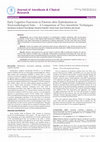
Journal of Anesthesia & Clinical Research, 2011
Background: Less is known about prevalence of postoperative cognitive dysfunction after neurosurg... more Background: Less is known about prevalence of postoperative cognitive dysfunction after neurosurgical procedures. A Hindi version of Mini Mental State Examination (HMSE) is widely used for illiterate Hindi speaking population in the Indian subcontinent for assessment of cognitive dysfunction. The aim of the study was to assess effects of anesthetics on neurocognitive function in patients undergoing interventional procedure in neuroradiological suite. Methods: Twenty five patients with intracranial arterio-venous malformations and cerebral aneurysms were randomized to receive intravenous (propofol) or inhalational anesthetic (isoflurane). HMSE was performed in the ICU at 1 hour and 24 hours of tracheal extubation. Results: Baseline demographics like age and weight of patients differed significantly between the groups; however their cognitive functions were comparable. Intraoperative hemodynamic parameters like heart rate and mean arterial pressure were comparable between the two groups. Cognitive functions noted at the two time intervals in the postoperative period were also comparable between the two groups. Conclusion: We observed that anesthetic technique did not affect post embolization cognitive function, but, a better hemodynamic stability was maintained with total intravenous anesthesia. J o u rn al of A n e s th es ia & C li n ic a l Resea rc h
Saudi Journal of Anaesthesia, 2012
Letter to Editor Role of subarachnoid block in patient with dermatomyositis epidural needle (16 o... more Letter to Editor Role of subarachnoid block in patient with dermatomyositis epidural needle (16 or 18 G) needle, more quantity of local anesthetic use and risk of dura puncture, we decided to give sub arachnoid block with the finest needle available. Especially in lower limb surgery, one should avoid general anesthesia due to its known complications in such cases. In conclusion, one may apply sub arachnoid block in selective patients with dermatomyositis and can minimize the complications associated with use of muscle relaxants and other anesthetics.
Saudi Journal of Anaesthesia, 2013
passing the scope into the oropharynx without further traumatizing the nasopharyngeal structures.... more passing the scope into the oropharynx without further traumatizing the nasopharyngeal structures. Moreover, in conditions with secretions and bleeding, it becomes difficult to visualize by FOB. In summary, airway management in patients with previous cleft palate surgery will always be a challenge for the anesthesiologist and will influence the method of airway control. Thorough preoperative assessment to rule out persisting palatal defect coupled with judicious implementation of knowledge and skill is needed to avert the unwanted complication.
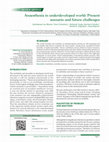
Nigerian Medical Journal, 2014
Total perioperative mortality decreased progressively over the decades, from 10,603 per million b... more Total perioperative mortality decreased progressively over the decades, from 10,603 per million before the 1970s, to 4533 per million in the 1970s-80s, and 1176 per million in the 1990s-2000s. Although there is significant reduction in anaesthesia-related perioperative mortality during the last 50 years, patients undergoing surgery in low-income group countries still have two to three times increased mortality risk compared with high-income group countries. 1 Therefore, it is obvious that growth in every area of health care sectors across SUMMARY The overall mortality and morbidity in underdeveloped countries are still unchanged and preventable risks factors constitute the main burden. Among these, anaesthesia-related mortality is largely preventable. Various contributory factors related to human resources, technical resources, education/teaching system and other utilities needs further attention in poor income group countries. Therefore, we have made an attempt to address all these issues in this educational article and have given special reference to those factors that might gain importance in (near) future. Proper understanding of anaesthesia-related resources, their overall impact on health care system and their improvisation methods should be thoroughly evaluated for providing safer anaesthesia care in these countries which would certainly direct better outcome and consequently influence mortality.
Nigerian Medical Journal, 2013
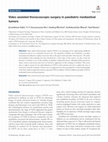
Journal of Paediatrics and Child Health, 1995
Video assisted thoracoscopic surgery (VATS) is an emerging tool for approaching childhood mediast... more Video assisted thoracoscopic surgery (VATS) is an emerging tool for approaching childhood mediastinal tumors in a minimally invasive way. The magnified visibility and availability of smaller instruments has allowed to explore even areas close to the great vessels and other vital structures. The safety and feasibility of this technique has been described for a wide range of these tumors. In spite of that the literature is deficient in use of this modality in paediatric mediastinal tumors. Although widely practiced in adults, various controversies have been set forward in application of this technique in children. This article aims to explore reasons for the underutilisation of VATS in these patients and tries to explain the areas of controversy with this technique. Various ways of comparison have been attempted for a broad understanding of the finer details (comparisons between open and VATS in children, VATS in children and adults, VATS in mediastinal tumors and lung surgeries).
PubMed, Aug 17, 2018
The patients often present to palliative care with intractable nausea and vomiting. This may redu... more The patients often present to palliative care with intractable nausea and vomiting. This may reduce the effectiveness of oral drugs and significantly affects the quality of life of these patients. Despite multiple drugs available for treatment, it is often difficult to control the symptoms. Olanzapine is an atypical antipsychotic and acts on multiple receptors and may help in treating vomiting in a patient with advanced malignancy. We report a case of gallbladder carcinoma who presented to us with intractable vomiting which was not relieved with a combination of traditional antiemetics but showed marked improvement with olanzapine.
Palliative Medicine in Practice, Jan 13, 2023
This article is available in open access under Creative Common Attribution-Non-Commercial-No Deri... more This article is available in open access under Creative Common Attribution-Non-Commercial-No Derivatives 4.0 International (CC BY-NC-ND 4.0) license, allowing to download articles and share them with others as long as they credit the authors and the publisher, but without permission to change them in any way or use them commercially.
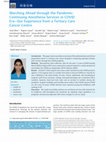
South Asian Journal of Cancer, Mar 2, 2023
Introduction This paper aims to provide an overview of the administrative and clinical preparatio... more Introduction This paper aims to provide an overview of the administrative and clinical preparations done in a tertiary care cancer hospital in continuing operation theatre (OT) services through the COVID pandemic. Methods Retrospective data collection, data for the past 1.5 years (COVID period) March 2020 to August 2021 were compared to surgical output for a similar duration of time before the COVID era (September 2018-February 2020). Results A total of 1,022 surgeries were done under anesthesia in the COVID period as against 1,710 surgeries done in a similar time frame in the pre-COVID era. Overall, we saw a 40%drop in the total number of cases. Thorax, abdominal, and miscellaneous surgeries (soft tissue sarcomas, urology, and gyneconcology) saw a maximum fall in numbers; however, head and neck cases saw an increase in numbers during the pandemic. Surgical morbidity and mortality were similar in the COVID and pre-COVID era. No cases of severe COVID infection were reported among the healthcare staff working in OT. Discussion We could successfully continue our anesthesia services with minimal risk to healthcare staff throughout the pandemic by adopting major guidelines in a pragmatic and practical approach with minor changes to suit our setup.
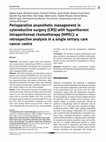
Pleura and peritoneum, May 30, 2022
Objectives: Cytoreductive surgery (CRS) with hyperthermic intraperitoneal chemotherapy (HIPEC) is... more Objectives: Cytoreductive surgery (CRS) with hyperthermic intraperitoneal chemotherapy (HIPEC) is associated with increased morbidity and mortality. We retrospectively analysed the perioperative anesthetic management in patients undergoing HIPEC surgery. Methods: After ethics approval, we reviewed the records of patients who underwent CRS/HIPEC from 2015 until 2020. We noted the peritoneal carcinomatosis index (PCI), blood loss, anastomoses done, total amount of fluid given, delta temperature and duration of surgery. These were correlated with the need for postoperative ventilation, length of ICU stay, Clavien-Dindo score and 30 day mortality. Results: Of the 180 patients reviewed, the majority were women (85%) with a mean age of 48 years who had ovarian tumors (n=114). The total amount of fluid given was associated with an increased length of ICU stay (p=0.008). Prolonged surgery resulted in increased length of ICU stay (p<0.001), need for postoperative ventilation (p=0.006) and a poor Clavien-Dindo score (p=0.039). A high PCI score correlated with increased ICU stay, 30 day mortality (p<0.001), and the need for postoperative ventilation (0.005). Conclusions: PCI, duration of surgery and blood loss were major predictors of postoperative morbidity. Additionally, the amount of fluid given and delta temperature affected patient outcome and should be individualized to the patient's needs.
Uploads
Papers by Sachidanand Jee Bharati